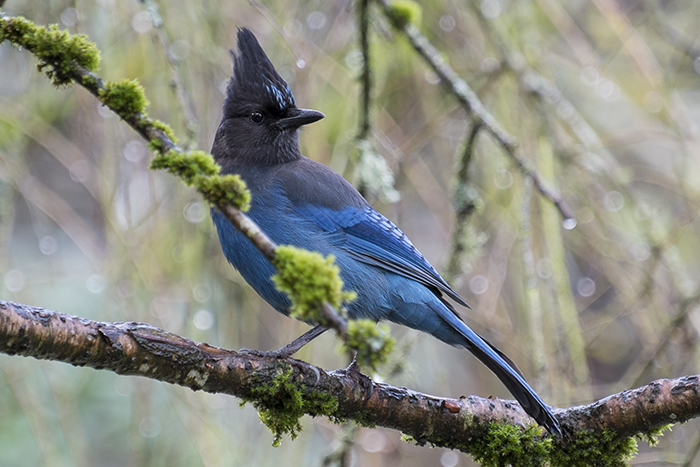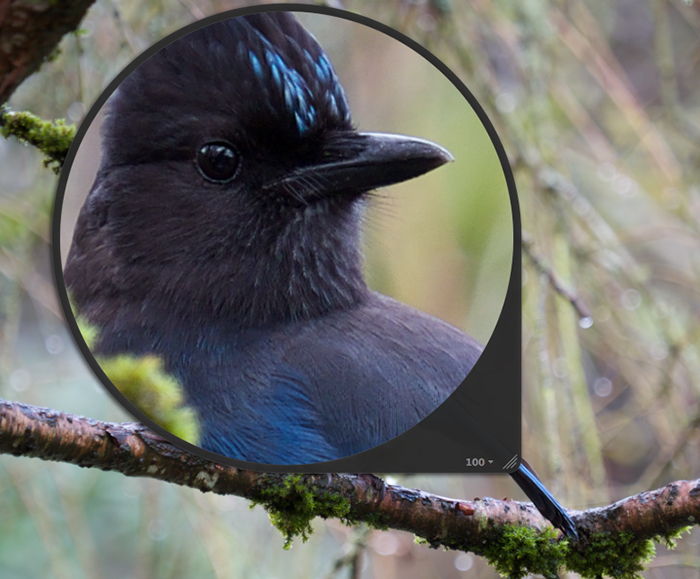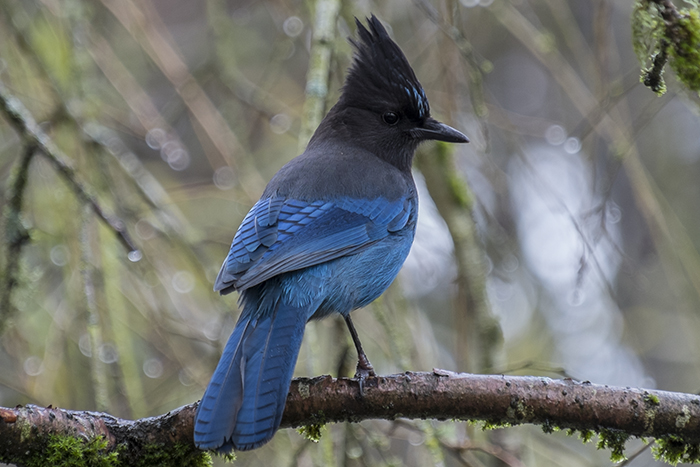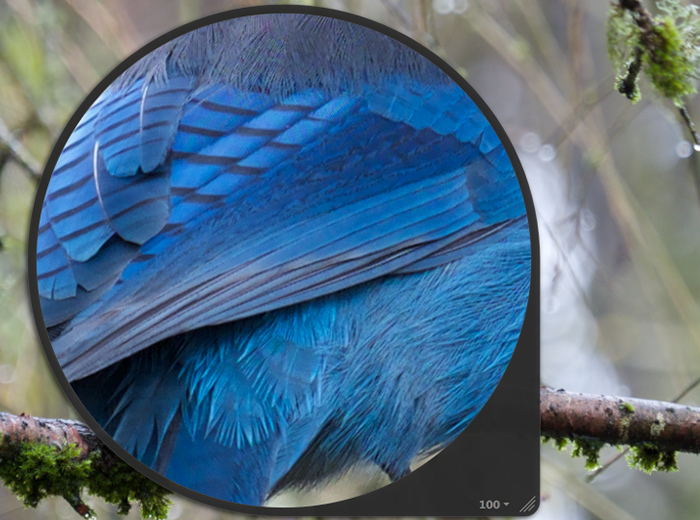Camera: Fuji X-Pro1
Exposure: 1/50
Aperture: f/4.8
Focal Length: 200mm (300mm full frame equivalent)
ISO: 400
This Steller’s Jay (Cyanocitta stelleri) was seen in Portland, Oregon. I’ve photographed a Steller’s Jay before and even talked about birding with the Fuji cameras before, though with a Zeiss spotting scope for a lens instead of Fuji lenses. This time however, I used the Fuji 55-200 f/3.5-4.8 lens wide open at 200mm in totally flat light and was stunned by the results. The sharpness and color rendition is simply unparalleled in a zoom lens and puts to shame the images of the same bird seen using the Canon 1D MkIV and the Canon EF 70-300mm f/4.5-5.6 L IS USM.
The advantage of the Fuji sensors comes from a few factors, but notably, the lack of an anti-aliasing filter which they are able to easily get rid of because of the way the pixels are laid out on the X-Trans sensor. This is important because regularly repeating red, green and blue imaging sensors can induce moiré which can be a problem with repeating, high frequency patterns (like bird feathers). Fuji arranged the pixels on their X-Trans sensor in a semi-random array and then got rid of the low-pass filter on their imaging sensor which makes for sharper images than seen on other cameras. Yes, you can get Leica cameras, Sony cameras and Nikon cameras without the aliasing filter, but because they are still using traditional pixel layouts, moiré can raise its ugly head when photographing bird feathers and other things with high-frequency repeating patterns.
The other thing that really impressed me was Fuji’s 55-200 zoom lens. While I’ve raved about how good Fuji’s prime lenses were before, this was the first time I’ve really looked hard at the sharpness from the 2nd zoom lens Fuji ever released for the X-mount system, the 55-200. The image immediately above is a 100% crop from the intro image at top, made handheld at the far end of the zoom range, 1/50th and wide open at f/4.8. Check out the rictal bristles (the short little feathers poking out at the base of the beak).
Camera: Fuji X-Pro1
Exposure: 1/70
Aperture: f/4.8
Focal Length: 200mm (300mm full frame equivalent)
ISO: 400
These next two images show more of the detail of the wings and tail feathers as well as another 100% zoom showing detail, again… with the Fuji 55-200mm zoom lens. While the resolution on the images above is impressive, I am also impressed by the color handling of not only the Fuji X-trans sensor which is pretty dramatic when you compare the older images of Steller’s Jay made with the Canon vs. these images, but the complete lack of chromatic aberration of the Fuji 55-200 lens. Its stunning that there is essentially no chromatic aberration, *very* low distortion and no vignetting as these issues are not only optically corrected, but also corrected by the camera in software processing of the image when captured. What comes out of the camera is more optically and chromatically refined than any zoom lens I’ve ever used. Ever.
Finally, I was pushing the lenses a little bit playing with the image stabilization which was absolutely silent and very effective. While I’ve been very pleased with the image stabilization on the Canon lenses, it is not nearly as silent as the Fuji lenses which is a big deal for birding with a camera. Autofocus on this lens is relatively quick, though not as fast as say the Canon 1DX and 70-300 lens. Though I am very much looking forward to the Fuji X-T1 as everything I am hearing from David and Zack (they already have the earliest copies released) seems to indicate that the autofocus on the X-T1 is truly impressive. If the autofocus performance of this lens on the X-T1 is substantially faster and more accurate than it is on the X-Pro1, it’ll be a game changer for people that want to shoot action with mirrorless cameras.
While the Fuji 55-200 is a little big on the X-Pro1, my guess is that the X-T1, particularly with the additional battery grip will feel much more balanced. That said, the image quality from this lens makes it a perfect companion to a Fuji X-mount system for those looking for a little extra zoom reach and has earned its place in my travel camera bag right along side my trusty X-Pro1 and for birders, like my friend Chuq, it makes perfect sense.




Stellar example of a Steller’s Jay. :) I’ve only seen these at Yellowstone and got a couple of shots, but nothing as nice as this. At least at Yellowstone they liked to hang out near the campsides trying to scavange food near the tents. I bet they are a lot more shy out in the “real world”.
Heh, thanks Ruben.
I *really*, really need to get back up to Yellowstone. its been far too long since I’ve visited there. Perhaps this summer and I’ll bring all of the Fuji gear!
As an owner of Fuji’s 55-200, I too have been impressed — but it hardly seems fair to draw color comparisons against Canon considering the images were obviously taken under very different lighting conditions. Also — it would be really neat to see equivalent 100% crops from the Canon rig.
Nice photos btw!
Hey Richard,
Yeah, they were taken in differing lighting conditions, but they should have favored the time I used the Canon 1D IV. Also, note: I am not saying the Canon gear is poor quality and I still shoot work with that gear. I’m just saying that the Fuji stuff is kinda blowing me away right now in image quality. Its not just this example either. Search under Fuji on this blog and you’ll see lots of examples.
Nice pictures. Were they cropped? Were you far from the bird?
Thank you. They were not cropped. The zoomed in loupe shows the 100x magnification.